Service Blueprinting is the process of illustrating how a user journey is delivered. The intent is to diagnose opportunities for operational efficiency about how you deliver your service or your experience to the user. Service Blueprints show the holistic view of an experience stage by stage, both on the user’s side and on the organization’s side.
Difference between Journey Mapping & Service Blueprinting
Journey Mapping and Service Blueprinting both look at the holistic view of an experience in the current state, not a future or ideal state. However, Service Blueprinting looks at the internal workings of an organization through each stage. These terms often get confused, but Service Blueprints work off the user journey with additional layers and tiers of detail that include front stage actions (actions seen by the user), backstage actions (actions that are not seen by the user) and also supporting systems. These additional details can include things like time, channels, or quality metrics. They’re very customizable, similar to experience maps or journey maps.
Benefits/Importance of Service Blueprinting
Service Blueprinting is a great tool to use for service-led companies or organizations to determine why user actions are occurring, and prioritize company initiatives. It also provides clarity into when different teams in the organization need to communicate to transition to the next stage or share resources. When doing a service blueprinting session, be sure to include a diverse group of team members from different levels of the company to ensure front stage and back stage actions are correctly defined.
Another benefit of Service Blueprinting is that it allows you to have all information in one place. It’s a very powerful tool for both the client team to see a full scope, as well as the partner team to be able to understand how everything is connected and avoid making decisions based on false assumptions. Once the whole ecosystem is mapped out, that’s where everyone can begin to more confidently proceed with recommendations. There is a lot of value in putting what is institutional knowledge on a single piece of paper. You can see how everything is connected and it becomes much clearer where the points of failure, or opportunities are, to enhance user experience, to gain operational efficiencies, or to clean up some of the chaos that tends to be organically built into old processes.
How/When to Use Service Blueprinting
Service Blueprints are most often used for service design, but they can also be used for experience design. When there is a lot of cross-functional complexity, Service Blueprinting can make experiences or supporting systems much simpler and more efficient to use. Service Blueprints are especially helpful if you’re looking for ways to reform an internal system, cut costs, or provide a service or product more efficiently.
Example of Service Blueprinting
You are an organization that provides weekly nutrition coaching to users. You frequently find users cancel after three months. As a team, you have a service blueprinting session to determine where clients usually drop off, and what to do about it.

How to apply Service Blueprinting
- As a group, define critical path stages the persona moves through from beginning to end of a service experience.
- Create swim lanes that define user actions, front stage actions, backstage actions, and support for each stage.
- User actions are steps the user takes in the experience, and should be laid out in chronological order.
- Front stage actions are performed by individuals in your organization who have direct contact with the user, and can be seen by the user.
- Backstage actions are completed by individuals in your organization that enable the front stage actions, and are not seen by the user.
- Support processes are automations or third parties that help you deliver on your services.
- Draw lines to connect related actions and support with arrows indicating workflow.
- Analyze the blueprint to define pain points
- Vote on the most severe pain points to determine where to focus your energy on improving your process.
